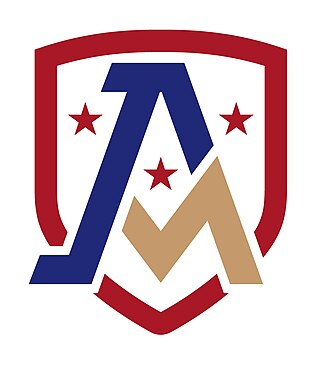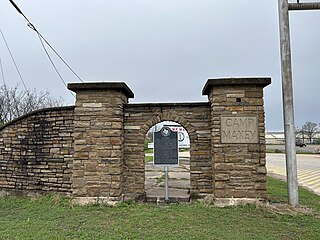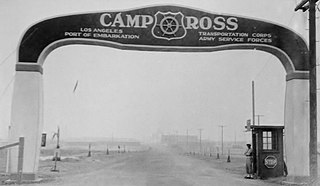
A prisoner of war (POW) is a person who is held captive by a belligerent power during or immediately after an armed conflict. The earliest recorded usage of the phrase "prisoner of war" dates back to 1610.

Belle Isle is a54-acre (22 ha) island in the city of Richmond, Virginia on the James River, and is part of the James River Park System. It is accessible to pedestrian and bicycle traffic via a suspension footbridge that runs under the Robert E. Lee Memorial Bridge from the northern shore or via a wooden bridge from the southern shore. Except when the water level of the James is high, it is also reachable by foot from the southern shore via easy boulder-hopping. From Belle Isle, one can see Hollywood Cemetery, the old Tredegar Iron Works, and Richmond City's skyline. There are many bike trails around the island as well as a small cliff used for rock climbing instruction.

California's involvement in the American Civil War included sending gold east to support the war effort, recruiting volunteer combat units to replace regular U.S. Army units sent east, in the area west of the Rocky Mountains, maintaining and building numerous camps and fortifications, suppressing secessionist activity and securing the New Mexico Territory against the Confederacy. The State of California did not send its units east, but many citizens traveled east and joined the Union Army there, some of whom became famous.

Camp Atterbury-Muscatatuck is a federally owned military post, licensed to and operated by the Indiana National Guard, located in south-central Indiana, 4 miles (6.4 km) west of Edinburgh, Indiana and U.S. Route 31. The camp's mission is to provide full logistical and training support for up to two brigade-sized elements simultaneously. The Camp offers a variety of training ranges, live-fire venues, managed airspace with air-to-ground fighting capabilities and an LVC simulation and exercise center. It is also the normal Annual Training location for National Guard and Reserve forces located in Indiana.

Stalag IV-A Elsterhorst was a World War II German Army prisoner-of-war camp located south of the village of Elsterhorst, near Hoyerswerda in Saxony, 44 kilometres (27 mi) north-east of Dresden. It held Polish, French, Belgian, British, Serbian, Soviet, Dutch, Italian, American, Slovak, Czech, Bulgarian and other Allied POWs.

Camp Maxey is a Texas Military Department training facility that was originally built as a U.S. Army infantry-training camp during World War II. It was occupied from July 1942 to early 1946, and located near the community of Powderly, Texas in the north central portion of Lamar County, Texas. Its main entrance was located nine miles north of Paris, Texas. Planning for the 70,000-acre military post began in 1940, soon after the National Military Draft was ordered; the planning accelerated in 1941 shortly before the United States entered World War II in December 1941.

Camp Anza was a United States Army installation, in what is now Riverside, California, during World War II. Construction began on July 3, 1942, and was completed on February 15, 1943. The camp was named after Juan Bautista de Anza, an early explorer who camped near the site in 1774. The US Army purchased the 1,240-acre site from the Willits J. Hole Ranch (1910–1942), a barley and wheat farm. Before 1910 the land was part of Rancho La Sierra (1797–1910).

Camp Kohler was located in the northeast corner of unincorporated Sacramento County, California, United States, until it was destroyed by a fire in 1947. Initially a camp for migrant farm workers, it became the Sacramento Assembly Center a temporary detention center for interned Japanese Americans in 1942. The site is one of 12 California assembly centers that share designation as California Historical Landmark No. 934. From 1943 to 1945 the camp was a training center for US World War II forces.
Brent Prescott's Camp Ono existed from 1942 to 1947 in Southern California on 300 acres of land. The camp was four miles northwest of the City of San Bernardino, California.

The Temporary Detention Camp for Japanese Americans / Pomona Assembly Center is one of the places Japanese Americans were held during World War II. The Pomona Assembly Center was designated a California Historic Landmark on May 13, 1980. The Pomona Assembly Center is located in what is now called the Fairplex in Pomona, California in Los Angeles County. The Pomona Assembly Center was called Los Angeles County Fairgrounds in 1942.

The Camp Coxcomb was a sub camp of the US Army Desert Training Center in Riverside County, California. The main headquarters for the Desert Training Center was Camp Young where General Patton's 3rd Armored Division was stationed. Camp Coxcomb was designated a California Historic Landmark (No.985). The site of the Camp Granite is 45 miles East of Indio, California off Interstate 10 and California State Route 177 near the Coxcomb Mountains. The train stop at Freda railroad siding delivered Troops and equipment. The camp closed in early in 1944 after about two years of operations.

Camp Ross was a World War II base serving as a staging area under the command of the Army's Los Angeles Port of Embarkation. The camp was located in San Pedro, California and Wilmington, California. The United States Department of War leased 31.026 acres of land starting in 1942. Camp Ross was used by the US Army as staging area for troops ready for deployment and for troop returning home to Naval Operating Base Terminal Island.

California during World War II was a major contributor to the World War II effort. California's long Pacific Ocean coastline provided the support needed for the Pacific War. California also supported the war in Europe. After the Japanese attack on Pearl Harbor on December 7, 1941, most of California's manufacturing was shifted to the war effort. California became a major ship builder and aircraft manufacturer. Existing military installations were enlarged and many new ones were built. California trained many of the troops before their oversea deployment. Over 800,000 Californians served in the United States Armed Forces. California agriculture, ranches and farms were used to feed the troops around the world. California's long coastline also put the state in fear, as an attack on California seemed likely. California was used for the temporary and permanent internment camps for Japanese Americans. The population grew significantly, largely due to servicemen who were stationed at the new military bases/training facilities and the mass influx of workers from around the U.S. in the growing defense industries. With all the new economy activity, California was lifted out of the Great Depression. Over 500,000 people moved to California from other states to work in the growing economy. California expanded its oil and mineral production to keep up with the war demand.

Camp Haan was a US Army training camp built in 1940, near March Air Force Base in Riverside County, California Camp Haan was opened in January 1941 as a training camp for Coast Artillery Antiaircraft gunners. The 8,058 acres camp was about four miles by three miles with tent housing. The camp was named after Major General William George Haan of World War I. By the end of 1941, the camp had a wood service building, 28 miles of streets, five chapels, and a hospital. The first troops trained were sent for the defense of Los Angeles and San Francisco. The Attack on Pearl Harbor and the Battle of Los Angeles–Bombardment of Ellwood had put all of California on high alert. The Army Service Depot was added to the camp in March 1942. The site of the former Camp Haan is next to California Interstate 215 at the Van Buren Boulevard exit.

Birmingham General Hospital was a World War II US Army Hospital in Van Nuys, California at the corner of Vanowen Street and Balboa Boulevard. The hospital was built in 1942 and 1943 to care for troops returning home from oversea service. The first patient checked-in on August 24, 1943. The hospital had 1,777 beds housed in single-story buildings over the 131-acre campus.
The Italian Service Units or ISUs were military units composed of Italian prisoners of war (POWs) that served with the Allies during World War II against Nazi Germany and the Empire of Japan from May 1944 to October 1945. The armed forces of the United States captured many Italian soldiers during the North African campaign Operation Torch, which started in November 1942 and sent 51,000 of them to the United States. After the signing of the armistice by the Badoglio government in Italy on September 8, 1943, and with Pietro Badoglio and the Kingdom of the South officially declaring war on Nazi Germany on October 13, 1943, the Americans began to see the POWs as potential allies. The capture of Rome by the Allies on June 4, 1944, motivated many POWs to change sides. About 90% joined Italian Service Units, which operated in the United States and overseas.

Camp Lamont also called Lamont Prisoner of War Base Camp was a World War II German Prisoners of War camp in the City of Lamont, California, 12 miles southwest from Bakersfield in Kern County. It was formed on December 2, 1944 by the US Department of Agriculture (USDA) transferring 16 acres of land to the US War Department for the US Army. Built at the camp were housing, a mess hall, fencing, guard towers and flood lights. In 1944, Japanese and German prisoners came to Camp Lamont from Camp Cooke, northwest of Lompoc, California. More came the next year from Camp McCoy in Wisconsin and Camp Clarinda in Iowa. Those not seen as a risk were given the option of volunteering to work crops in exchange for coupons they could spend in the camp exchange. They worked on cotton farms, picking the crops. Their labor was used to fill the labor shortage caused by the draft. Prisoners were taken each day by bus or truck to the fields to work. About 4494 German and Japanese POWs were housed at the camp. A German POW committed suicide in camp in early February, 1945. Camp Lamont ran two sub camps: Boswell Ranch, which opened in December 1944 in the city Corcoran, California in Kings County with 499 prisoners and closed October 5, 1945, and Camp Lakeland, also called the Corcoran Prisoner of War Branch Camp in Corcoran, with 631 prisoners, which opened May 14, 1945 and closed October 5, 1945. Camp Lamont itself closed on July 31, 1946. After the war the Camp Lamont land was returned to the USDA. The land is now private property, with only a few foundations marking the spot of the former camp.

Santa Monica Army Air Forces Redistribution Center or Redistribution Station No.3 was a complex of buildings and hotels located in Santa Monica, California used to house troops during and after World War 2. US Army Air Force picked the Santa Monica site as Douglas Aircraft Company has a large Aerospace manufacturer operated there at Clover Field, also called Santa Monica Army Air Base). Opened in November 1943, the Redistribution opened out of leased buildings and land, most on what is now the Santa Monica State Beach. Crews rotation from Europe war and the Pacific War were able to rest and relax before their next assignment. At its peak, the complex covered 65 acres and had a staff of 1,200. Many of the staff at the center were from the Women's Army Corps. Organized social events were put on by the Santa Monica-Ocean Park chapter of the American Red Cross. At the end of the war, the complex became a processing center for troops heading home. Over 35,000 airmen had been processed at the center. Next, the complex processed prisoners of war heading home. The complex was deactivated on 15 November 1945 and the last leased building was closed in January 1947. Most of the buildings are in what is called Ocean Park, California on Ocean Avenue. The Army Air Force operated other Redistribution Centers in Atlantic City, Miami, San Antonio, Greensboro and Santa Ana, California at Camp Davis.

Hammond General Hospital, or Hammond Army Hospital, was a large United States Army medical treatment facility during World War II, located in the city of Modesto in Stanislaus County, California, and in operation from 1942 until 1946. The facility was preceded by the Modesto State Hospital, a public psychiatric hospital in operation from 1946 to 1972.




















